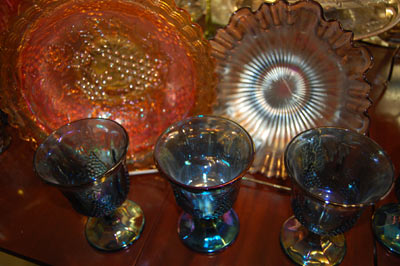Speaking of Antiquing – April 2015
In 1907, the Fenton Glass Company in West Virginia produced a style of glass referred to as “iridescent ware.” Fenton called it Iridill and labeled it “Venetian Art.” The idea was to mass-produce a beautiful product that could compete with the expensive, iridescent art glass made by Tiffany and Steuben.
The glass produced was beautiful, and with its multicolor shimmer, it gave the average housewife the ability to adorn her home with fancy vases and decorative bowls. It became known as “poor man’s Tiffany.”
Other companies soon followed the trend and thousands of patterns and pieces were produced in the USA and other countries as well.
The production of the glass involved pouring and pressing the molten glass into molds, then spraying the pressed glass piece with various metallic salts when it was hot from the mold, then re-fired. The glass is colored and coated with overspray that gives it the appearance of iridescence, as the quote goes, “as oil spreading over water.”
By the mid-1920’s iridescent glass fell out of favor and because of the high volume of production, thousands of pieces were sold cheaply to passing carnivals to use as prizes on their midways. As its value plummeted, iridescent ware was soon being given away as prizes at carnivals, where folks were able to win shimmering vases, tureens, and dishes of all shapes and colors by playing carnival games… thus gaining the name “carnival glass.”
This new market for carnival glass was a boon for Fenton, which produced iridescent ware in 150 patterns up until the late 1920s. Carnival glass was sold for mere pennies at five-and-dimes, and could be bought in lots at minimal cost. It was also given away as promotions at movie theaters and in grocery stories. Imperial glass struck lucrative deals with companies like Woolworth’s and Quaker Oats, it was everywhere.
In total, there were at least 2,000 different patterns of carnival glass. Fenton’s earliest patterns included Waterlily and Cattails, Vintage, Butterfly and Berries, Peacock Tail, Ribbon Tie, Wreath of Roses, Thistle, and Diamond and Rib. Northwood’s first iridized glass patterns were Waterlily and Cattails, Cherry and Cable, and Valentine, but Grape and Cable was the most popular. Millersburg collectors look for Hobstar and Feather, Blackberry Wreath, and Rays and Ribbons.
There are literally hundreds of websites and pages of information on the internet if one is willing to take the time to read and learn about the world of collecting carnival glass. The main rule I gleaned is: Iridescence is what collectors covet in Carnival Glass, if it is not iridescent it is not carnival glass. Be careful to look for even distribution of applied color, looking for bare spots or wear on the surface. Carnival glass is known for changing colors, an interplay of one hue against another. Be wary of buying worn or faded pieces. The better the color and quality of iridescence, the higher the price.
Carnival Glass has been reproduced and copied producing a generation of glass that does not attract the attention of true collectors. There are reissues, reproductions and fakes fooling the buyer into thinking they are purchasing an older more valuable piece.
Pickety Place has some interesting pieces from the classic era, so come on in and add to your collection.

 Margaret Barns is co-owner of Pickety Place Antiques & Collectibles located at 130 N. 4th Street in Jacksonville. LIKE them on
Margaret Barns is co-owner of Pickety Place Antiques & Collectibles located at 130 N. 4th Street in Jacksonville. LIKE them on